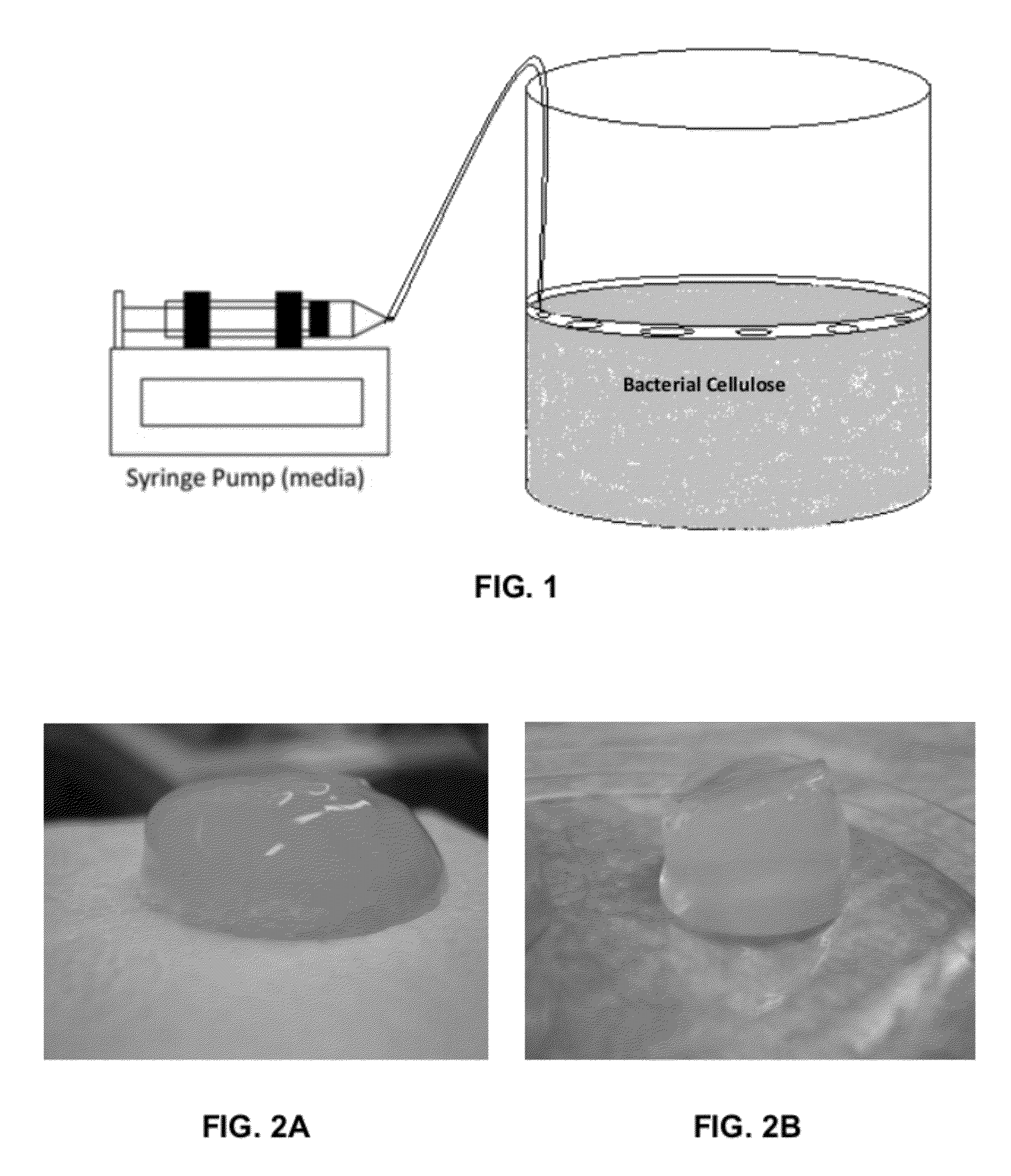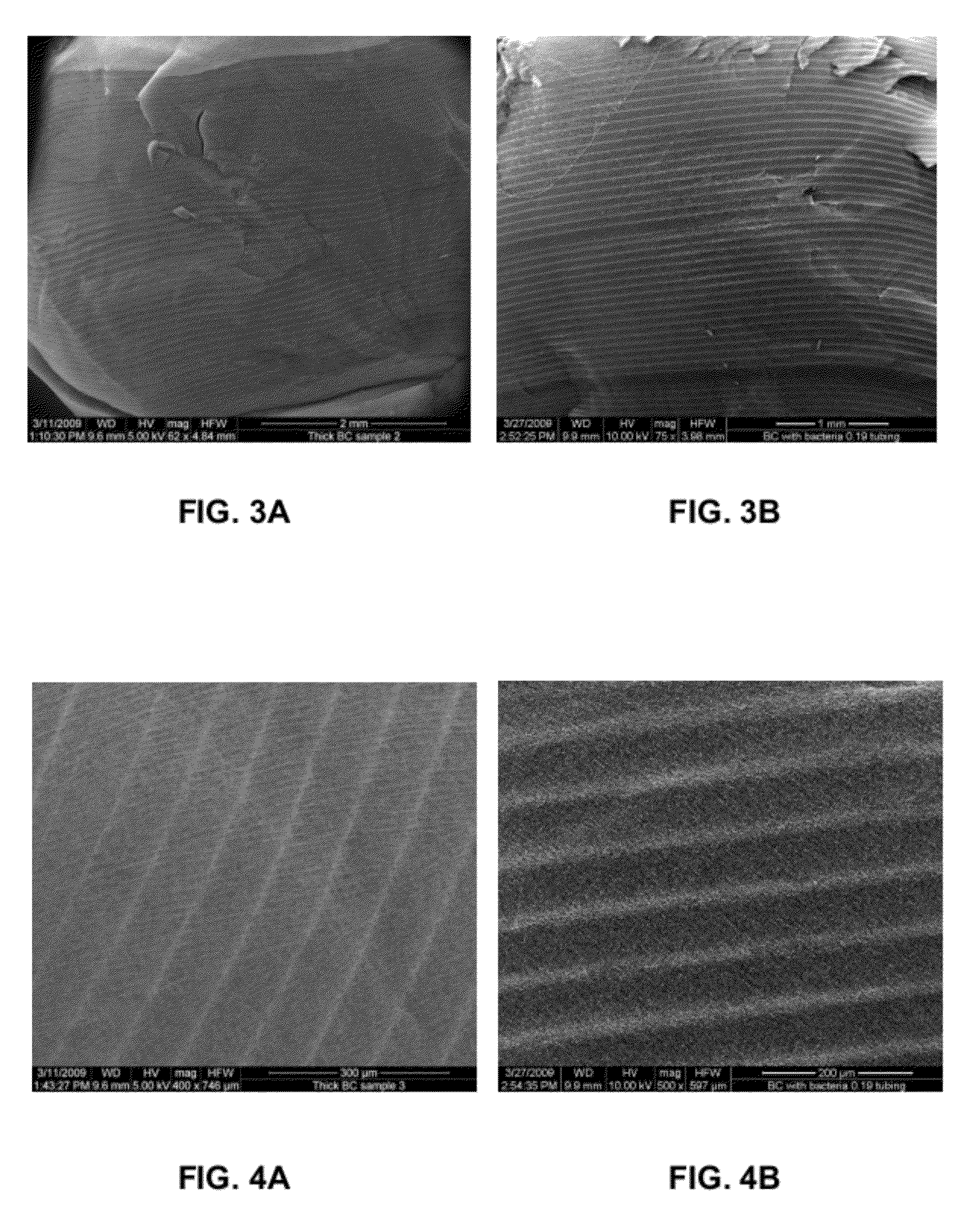Three-dimensional bioprinting of biosynthetic cellulose (BC) implants and scaffolds for tissue engineering
a bioprinting and biosynthetic technology, applied in the field of biomedical implants and devices, tissue engineering and regenerative medicine, and health care products, can solve the problems of immunological response, difficult to process these materials into porous scaffolds with predetermined morphology, and limited success of synthetic materials as implants, so as to optimize the thickness and strength of the resulting bc network, increase the level of culture media, and introduce porosity
- Summary
- Abstract
- Description
- Claims
- Application Information
AI Technical Summary
Benefits of technology
Problems solved by technology
Method used
Image
Examples
example 1
Production of Robust 3D BC Structure with Potentially Unlimited Thickness
[0053]For controlled 3D Biosynthetic Cellulose structure to grow, a medium administration system has been designed, which is shown schematically in FIG. 1. More particularly, in this embodiment, FIG. 1 provides a representative layout for an experimental set up in which a microfluidic media administration system comprising a syringe pump adds a small amount of media to a porous floating ring, which slowly diffuses media into continuously growing cellulose, which grows at the air liquid interface, thereby forming a new layer of cellulose inside the floating ring.
[0054]Any means for administering the media can be used. Preferably, administration systems capable of controlling the rate and / or volume of media addition are highly desired. The system was composed of syringe pump, 100 ml sterile syringe and sterile silicone tubing. 100 ml of medium composed of (fructose [4% w / vl], yeast extract [0.5% w / v], (NH4)2SO4 [...
example 2
Production of Multilayer BC Structures with Variation of Properties in Various Layers
[0062]The thickness of the 3D structure produced in experimental set up shown in FIG. 1 and with details described in Example 1 has been modified by addition from the second syringe pump sterilized distilled water. That stopped the cellulose growth. Upon completion of the first BC scaffold layer, an additional 0.025 mL of culture media was added on the top of the surface covering the existing layer. Bacteria suspension taken from preculture was added on the top of the pellicle and the new a pellicle was grown at the liquid-air-interface. This process was repeated. Since we found that the medium addition rate affected morphology and robustness of each layer we have performed experiments with varying medium addition rate. We were able to produce multilayer structures with variation of morphology and mechanical properties. This is of great importance when the BC material is used as implant and the diff...
example 3
Production of large 3D BC Robust Structures with Exact Predetermined Shape
[0063]Using the experimental set up as described in Example 1 and displayed in FIG. 1, large 3D BC robust structures can be prepared. The system was composed of syringe pump, 100 ml sterile syringe and sterile silicone tubing. 100 ml of medium composed of (fructose [4% w / vl], yeast extract [0.5% w / v], (NH4)2SO4 [0.33% w / v], KH2PO4 [0.1% w / v], MgSO4.7H2O [0.025% w / v], corn steep liquor [2% v / v], trace metal solution [1% v / v, (30 mg EDTA, 14.7 mg CaCl2.2H2O, 3.6 mg FeSO4.7H2O, 2.42 mg Na2MoO4.2H2O, 1.73 mg ZnSO4.7H2O, 1.39 mg MnSO4.5H2O and 0.05 mg CuSO4.5H2O in 1 liter distilled water)] and vitamin solution [1% v / v (2 mg inositol, 0.4 mg pyridoxine HCl, 0.4 mg niacin, 0.4 mg thiamine HCl, 0.2 mg para-aminobenzoic acid, 0.2 mg D-panthothenic acid calcium, 0.2 mg riboflavin, 0.0002 mg folic acid and 0.0002 mg D-biotin in 1 liter distilled water)]) was sterilized by microfiltration and placed in the sterile syring...
PUM
| Property | Measurement | Unit |
|---|---|---|
| Tensile strength | aaaaa | aaaaa |
| Tensile strength | aaaaa | aaaaa |
| Thickness | aaaaa | aaaaa |
Abstract
Description
Claims
Application Information
 Login to View More
Login to View More - R&D
- Intellectual Property
- Life Sciences
- Materials
- Tech Scout
- Unparalleled Data Quality
- Higher Quality Content
- 60% Fewer Hallucinations
Browse by: Latest US Patents, China's latest patents, Technical Efficacy Thesaurus, Application Domain, Technology Topic, Popular Technical Reports.
© 2025 PatSnap. All rights reserved.Legal|Privacy policy|Modern Slavery Act Transparency Statement|Sitemap|About US| Contact US: help@patsnap.com



